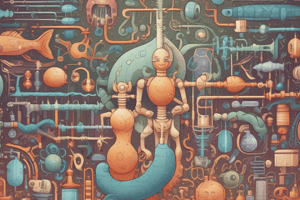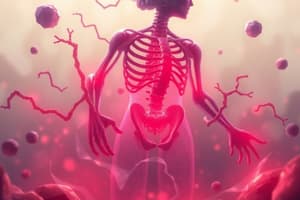Podcast
Questions and Answers
What is the primary function of amino acids in the liver?
What is the primary function of amino acids in the liver?
- Gluconeogenesis and glycolysis
- Energy storage
- Fatty acid degradation
- Protein synthesis and energy production (correct)
Where do amino acids for peripheral protein synthesis come from during the absorptive period?
Where do amino acids for peripheral protein synthesis come from during the absorptive period?
- The liver
- The portion of amino acids that escape hepatic catabolism (correct)
- The muscle tissue
- The bloodstream
What is the byproduct of amino acid catabolism in the liver?
What is the byproduct of amino acid catabolism in the liver?
- Fatty acids and glycerol
- Ammonia (NH3) and α-keto acids (correct)
- Lactic acid and pyruvate
- Glucose and ATP
What happens to excess amino acids that are not used for biosynthetic needs?
What happens to excess amino acids that are not used for biosynthetic needs?
What is the eventual fate of the carbon skeletons of α-keto acids?
What is the eventual fate of the carbon skeletons of α-keto acids?
Why are amino acids not stored in the body?
Why are amino acids not stored in the body?
What is the primary function of the urea cycle in mammals?
What is the primary function of the urea cycle in mammals?
What is the result of deamination in amino acid metabolism?
What is the result of deamination in amino acid metabolism?
What is the difference between BUN and urea measurements?
What is the difference between BUN and urea measurements?
What is the fate of ammonia in mammals?
What is the fate of ammonia in mammals?
What is the significance of Antoine Lavoisier's quote in the context of amino acid metabolism?
What is the significance of Antoine Lavoisier's quote in the context of amino acid metabolism?
What is the nitrogenous waste product excreted by birds and reptiles?
What is the nitrogenous waste product excreted by birds and reptiles?
What is the charge of aspartate and glutamate at physiological pH?
What is the charge of aspartate and glutamate at physiological pH?
What is the function of histidine's side chain?
What is the function of histidine's side chain?
What is the derivative of tyrosine that is an inhibitory neurotransmitter?
What is the derivative of tyrosine that is an inhibitory neurotransmitter?
What is the result of hydroxylation of tyrosine?
What is the result of hydroxylation of tyrosine?
What is the function of oxytocin?
What is the function of oxytocin?
What is the importance of the liver in protein digestion?
What is the importance of the liver in protein digestion?
What is the fate of most dietary amino acids after absorption?
What is the fate of most dietary amino acids after absorption?
What is the derivative of tryptophan that plays a key role in digestion, mood, and sleep?
What is the derivative of tryptophan that plays a key role in digestion, mood, and sleep?
What type of amino acid is histidine?
What type of amino acid is histidine?
What is the derivative of tyrosine that is involved in lipid oxidation?
What is the derivative of tyrosine that is involved in lipid oxidation?
Flashcards are hidden until you start studying
Study Notes
Amino Acid Metabolism
- Amino acid concentration in blood is kept relatively constant, similar to glucose concentration.
- Amino acids are used in the liver for protein synthesis and energy production.
Amino Acid Metabolism - Degradation
- In the liver, amino acids are catabolized into ammonia (NH3)/urea (amine part of AA) and α-keto acids (the carbon skeletons of AA).
- The carbon skeletons of α-keto acids are converted to common intermediates of energy-producing metabolic pathways.
- These intermediates can be metabolized by central pathways of metabolism (e.g., gluconeogenesis, glycolysis, TCA cycle) to produce ATP, CO2, and H2O.
- Excess amino acids are rapidly degraded, as they are not stored in the body.
Amino Acid Characteristics
- Amino acids with charged side chains (basic or acidic) have a proton acceptor or donor function.
- At physiological pH, the side chains of these amino acids are fully ionized and positively charged.
- Histidine's side chain can be either positively charged or neutral, depending on the environment's pH, and plays an important function as a buffer.
Non-Polar and Polar Amino Acids
- Non-polar amino acids are located in the interior of soluble proteins and in membrane proteins.
- Polar amino acids are located on the surface of soluble proteins and in the hydrophilic regions of membrane proteins.
Amino Acid Derivatives
- Tyrosine derivatives: triiodothyronine (T3), thyroxine (T4), dopamine, and melanin.
- Taurine derivatives: bile acids.
- Glutamate derivatives: GABA (inhibitory neurotransmitter).
- Tryptophan derivatives: serotonin (neurotransmitter).
- Histidine derivatives: histamine (mediator of allergic reactions).
- Lysine derivatives: carnitine (involved in lipid oxidation).
Peptides with Physiological Relevance
- Oxytocin: a 9-amino acid peptide hormone produced in the hypothalamus, involved in uterine contractions and milk secretion.
- Antidiuretic hormone (ADH): a 9-amino acid peptide produced in the hypothalamus, essential for maintaining water balance.
- Creatine: a tripeptide involved in energy production in muscle and cardiac cells.
- Bradykinin: a 9-amino acid peptide, vasoactive substance.
- Angiotensin II: a 10-amino acid peptide, potent vasoconstrictor.
Protein Digestion and Amino Acid Metabolism
- Unlike fats and carbohydrates, amino acids are not stored by the body.
- Amino acids must be obtained from the diet, released through the degradation of body protein, or synthesized de novo from intermediate metabolites.
- Protein digestion starts in the stomach, where gastric juice (HCl and pepsinogen) breaks down proteins into peptides and amino acids.
- In the small intestine, pancreatic enzymes continue to break down proteins into absorbable peptides and amino acids.
- The liver plays a crucial role in regulating blood amino acid concentrations during periods of amino acid absorption.
Fate of Dietary Amino Acids after Absorption
- Most amino acids are removed by the liver on "first pass" (Hepatic Portal Circulation), never reaching the general circulation.
- The liver helps keep blood amino acid concentrations stable during periods of amino acid absorption.
Urea Cycle
- Ammonia is very toxic to the brain, and the body needs to keep its levels very low in plasma.
- In mammals, little free ammonia is excreted in urine; instead, it is converted to urea through the urea cycle.
- The urea cycle is the most important route for disposing of nitrogen from the body.
- Urea is excreted by the kidneys in urine.
Blood Urea Nitrogen (BUN)
- BUN is roughly one-half of the blood urea, measured by assaying the nitrogen component of urea.
- The BUN is an important parameter in evaluating kidney function.
Studying That Suits You
Use AI to generate personalized quizzes and flashcards to suit your learning preferences.




